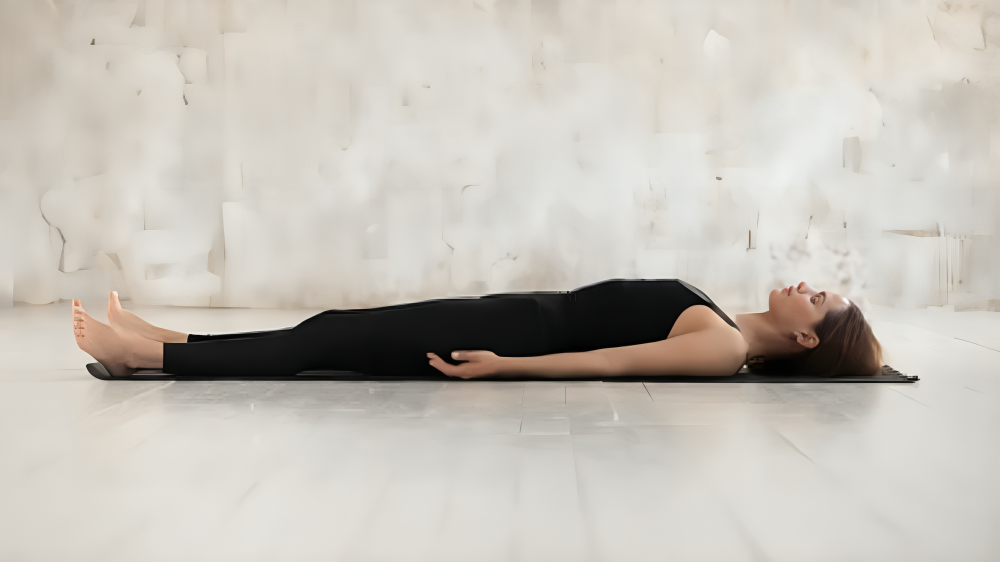
What is Savasana?
Savasana (pronounced shah-VAHS-uh-nuh) comes from the Sanskrit words “Sava,” meaning “corpse,” and “Asana,” meaning “pose.” It’s a pose that is symbolic of being still and in deep relaxation, letting your body fully relax after a yoga practice. It’s often done at the end of a yoga session but can also be practiced on its own whenever you want to relax.
How to Do Savasana
Find a Quiet Space
First things first, find a quiet and comfortable space where you won’t be disturbed. This could be on your yoga mat or any flat surface. Make sure the room temperature is comfortable too.
Lie Down Flat on Your Back
Lie flat on the floor with your legs extended. Let your arms be at your sides, with your palms facing up. The feet naturally fall open towards the sides. Ensure your body is straight from head to toe.
Relax Your Body
Close your eyes and start with deep breathing. With each exhalation, feel your body sink deeper into the floor, releasing any tension that might be stored in your muscles. Mentally scan your body, toes to feet, legs, hips, back, shoulders, arms, hands, neck to face, releasing conscious tension.
Bring your attention to your breath without trying to make any change in it-just observe your breath. Note the rising and falling of the diaphragm at every inhalation and exhalation. Let breathing be natural and regular.
Clear Your Mind
Now clear your mind of thought. It is quite all right if your mind racing with thoughts; just gently refocus on your breath when this happens. Imagine yourself floating upon a quiet sea, and that your thoughts are waves that pass by, not rocking your boat at all.
Stay Still and Present
Stay in this position for at least 5 to 10 minutes, or as long as you’re comfortable. The longer you stay, the greater the benefits. The key here is stillness-physically and mentally.
Come Out of Savasana Slowly
Coming out of the pose, first bring the consciousness back into the body. Wiggle the fingers and toes, then roll onto one side, staying there for a moment before slowly sitting up with eyes still closed. Take several deep breaths before opening the eyes to readjust to the waking world.
Benefits of Savasana
Reduces Stress and Anxiety
Savasana is amongst those poses recognized for bringing down the speed of the nervous system. One can only imagine how stress and anxiety levels can be brought down by focusing on one’s breathing and relaxing his/her body. That’s somewhat rebooting the brain!
Improves Concentration and Memory
This helps one become more aware of the present, hence enhancing concentration and memory. By regularly doing the Savasana pose, you will see how easily you focus and remember things.
Improves Sleep
Sleep problems bothering you? Savasana is here to help. That deep relaxation in this asana improves sleep quality as it regulates both falling asleep and maintaining sound sleep.
Reduces Blood Pressure
In this regard, studies have already suggested that Savasana lowers blood pressure by relaxing the person and reducing stress levels, hence also being a good practice for persons suffering from hypertension.
Takes Away Fatigue and Grants Energy to the Body
Although you are lying down, Savasana is energizing. Your body rests in such a deep way that it rejuvenates and refreshes you for the rest of the day with energy and focus.
Balances the Nervous System
Savasana is an asana that activates the parasympathetic nervous system, often called the “rest and digest” system. This works to rebalance the stress response in the body and instills a sense of calm and equanimity in the body and mind.
It’s here Halasana how to do it and what are the benefits
FAQs
Q: Who can practice Savasana?
A: Yes! Savasana is for everybody-from the very youngest child to the oldest adult-and for every body, regardless of physical ability or health. It’s a wonderful pose for beginning and experienced practitioners alike.
Q: How long should I stay in Savasana?
A: Generally, 5 to 10 minutes is adequate, but feel free to stay longer if you are comfortable. The important thing is to listen to your body and practice for the length of time that feels appropriate.
Q: Can I fall asleep in Savasana?
A: It’s common to feel sleepy, especially if you’re tired. But the goal is to be present and aware, so try to stay awake. If you do fall asleep, that’s okay, too! Your body probably needed the rest.

